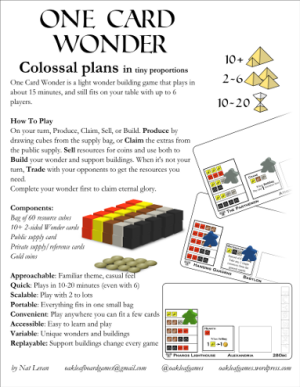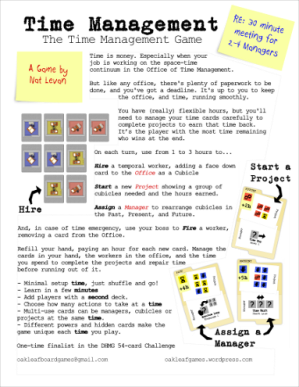Unpub 6 is coming up, and it’s time for me to gather the games I want to take. Besides the games, there’s something really important I need to take, and that’s Sell Sheets for each of the games I’m taking with me. I’m taking sell sheets for all of the games I’m going to play, even though I’m not planning on trying to pitch them all to publishers. There are several reasons behind that, and I want to share why I think they’re important, and how I create my sell sheets.
Why is it important to have sell sheets?
Well, the first and most obvious answer is that if I end up showing a publisher a game, I want to have something to give them. A Sell Sheet is an important part of a pitch. But a Sell Sheet isn’t just useful for showing publishers.
Sell sheets helps me be more noticeable. I have one game in the Unpub 6 Program, but I’m bringing many more that I’m hoping to get onto the table. I can bring a plastic stand and place the sell sheet into it, so people can see what the game is when they walk by. They can recognize it and identify it across the room. You might be sitting at the next table and see my sell sheet and decide to give the game a try.
Sell sheets also help me develop my introduction and overview for new players. You want to be able to explain your hook to anyone who expresses an interest. Developing a sell sheet helps you get to that hook and demonstrate the game, to attract new players and get them in as quickly as possible. It can also act as a visual aid during that discussion. And if you put a little thought into the art and graphic design, you can set the tone for the game before players even start learning about it.
Sell sheets can stand in for me if I’m busy explaining rules. Someone can walk up, read about the game, and decide if they want to come back without my needing to walk them through it. Obviously it’s better to actually engage with potential players, but if you’re already engaging with other people, it helps you sort of be in two places at once.
Sell Sheets force you to identify your audience is, and let your audience identify you. Hopefully you already know who the game is for, but you need to explicitly state it. “This is a game for anybody/everybody” doesn’t tell you anything about it. And when players come up, the first things players usually want to know are how heavy of a game is it, how much of a time commitment it takes, and whether the game is a good fit for them. A sell sheet makes those clear to everybody.
My Approach to Sell Sheets
I make my sell sheets for players as much as I make them for publishers. I think this is important because board game publishers are also board game players. Games get made because people want to play them. So my goal isn’t to sell the game as a product, but to convince you to sit down and play the game.
First, I have some overall advice. Talk directly to the player. There’s some debate about how to approach this in rulebooks, but I think it’s more effective in a pitch to talk directly to the player. Help them see themselves playing the game. Use active verbs. Don’t describe what the game does or what happens in the game, describe what the player is actually doing during play and what experiences they will have. Avoid meaningless words like “new”, “unique”, and “fun”, because they don’t add any information. I already expect it to be different from the games I have played, but it probably isn’t completely unique, and I’ll decide how fun it is myself.
Above are 3 examples of recent sell sheets. I break my sell sheet down into several areas. Obviously, the top has the title, big enough to read from a distance away. This also means clear enough. Go with a nice thematic typeface and style. But don’t make people to work to figure out the name of the game. They won’t. Below the title, I put some kind of tag line. For example, in One Card Wonder, I say “Colossal Plans in Tiny Proportions” to play on both the Colossus of Rhodes and the idea that you’re doing something big in a small box. But you don’t have to be clever. For Time Management, I simply used “The Time Management Game”. Find the 10 word hook that keeps people reading. Tiny wonder building, how does that work? The title is also the game mechanic, is this a joke? Next to the title, I have the time, player count, and player ages. These should also be big enough to quickly identify. Because I’m trying to attract attention, I try to put some thematic touches in these icons rather than just a basic box with text. For example on One Card Wonder, I used Pyramids. But if you’re sharing it directly with a publisher, simpler might be better.
The next portion is the heart of the pitch. Quickly introduce and explain the game, both thematically and mechanically. Who are you, what are you doing, how do you win? What does a turn look like? You should be able to explain the basic actions of the game in a paragraph or two at most. This is one of the hardest parts to write, but it is also the most important, because reading this is how someone decides to play without actually sitting down and looking at the game. And this is also how, a month later, someone will remember how to play your game.
The next portion is what comes in the box. This really just needs to be a list. But this is important both for people buying the game and publishers making the game, because it gives an idea of how much the game will cost. You don’t need to have photographs of the game, but you need to show the game components. Show the map. Show the board. Show the cards, tiles, tokens and how they interact.
Then, hit the highlights of your game. I like a bulleted list of why, as someone who buys boardgames, I would want to buy and play the game. What makes it a fun game? Include your hooks here, even if you’ve already mentioned them. What makes the game stand out? Is it a theme, or mechanical hook, or some twist on an existing game? If there’s something really clever or really fun, describe it. Talk about what excites you about the game, in concrete and specific terms, to get others excited.
What not to do in this section? Don’t just list mechanics. If players can’t figure out what mechanics are in the game the bottom of your sheet, you’ve already lost them. And don’t just list a bunch of qualities like “Replayable”. How do I know that? Is it a randomized setup? Are there variable player powers? What makes a game accessible, is it the theme or the mechanics or something else? What are the multiple uses for those multi-use cards? I also recommend not putting it in terms of “why the game will sell”. First, this isn’t a game yet. Second, Publishers worth working with are already thinking about it as a product. You’re not going to tell them something they don’t know.
Finally, don’t forget your name. No really. I’ve done this. Don’t forget to put your name on the sell sheet, along with your email address, Twitter handle, website, or whatever other method someone needs to get in touch with you.
Remember, a sell sheet isn’t just about selling your game. It’s about selling your idea, your excitement, and yourself. And a good sell sheet does that by making the best impression possible.
Helpful Links, with even more examples of sell sheets:
There are a lot of good examples of sell sheets out there, and a lot of good advice for how to build a good sell sheet. Here are some additional sites with examples of sell sheets.
http://www.leagueofgamemakers.com/how-to-build-a-sell-sheet-for-your-game/
https://inspirationtopublication.wordpress.com/2010/10/03/step-14-create-sales-sheets/
http://danielsolisblog.blogspot.com/2016/03/6-games-im-bringing-to-unpub-6.html
http://danielsolisblog.blogspot.com/search/label/sale%20sheet


